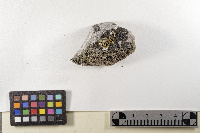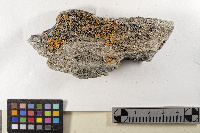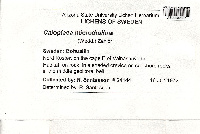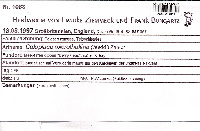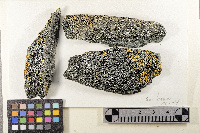
- Home
- Search
- Images
- Species Checklists
- US States: O-Z >
- US National Parks
- Central America
- South America
- US National Parks
- Southern Subpolar Region
|
|
|
|
Family: Teloschistaceae
[Caloplaca microthallina (Wedd.) Zahlbr., moreCaloplaca obliterascens (Nyl.) Zahlbr., Lecanora microthallina (Wedd.) Wedd., Lecanora obliterascens Nyl., Physcia microthallina (Wedd.) Arnold, Placodium microthallinum (Wedd.) H. Olivier, Placodium obliterascens (Nyl.) H. Olivier] |
Global occurrence: Eurasia – Europe | Americas – North America (incl Mexico) | Arctic. Substrate: lichens, lichenized fungi | rock – siliceous, siliciferous, acidic | rock – calcareous, calciferous, basic | rock, stones, pebbles – unspecified. Life habit: lichenized (mutualistic with algal photobionts). Thallus: squamulose (squamulous); [th] upper surface: red(dish) yellow (orange, orange yellow); [th marginal and upper surface] specific structures: absent; [th] morphol substructures (eg areoles, lobes, branches) width [mm]: (low) 0.5 (high) 2.0; [th] morphol substructures (eg areoles, squamules): discontiguous, dispersed (throughout the thallus); [th] morphol substructures (eg areoles, lobes, branches) upper surface: squamulose. Ascomata: absent | present; ascoma: apothecial, apothecioid – hymenial; ascoma [mm]: (min) 1.0; [ascm, if apoth] disc, mazaedium: plane, flat, flattened, expanded | convex; [ascm, if apoth] disc, mazaedium: red(dish) yellow (orange, orange yellow); [ascm, if apoth] margin surface; [if perith] periostiolar area, ostiole, involucrellum: red(dish) yellow (orange, orange yellow); [ascm] paraphyses/-oids: present; [ascm] paraphyses/-oid apical cells width [µm]: (median) 7.0. Asci: lecanoralean; [asc] tholus: thickened; [asc] tholus amyloidity (iodine reaction): present; [asc] tholus amyloidity pattern: entirely amyloid (= Catillaria-, Teloschistes-types etc). Ascospores: (median) 8.0; [asp] shape: ellipsoidal; [asp] length [µm]: (low) 12.0 (high) 15.0; [asp] width [µm]: (low) 6.0 (high) 8.0; [asp] septa: absent | present – spore lumen bilocular, polarilocular, plurilocular; transversely septate; [asp] transversal septa: (median) 1.0; [asp] pigmentation: hyaline, colourless; [asp] perispore, epispore: not apparent. Secondary metabolites: present; unknown/unidentified anthraquinone(s). Primary photobiont: present, chlorophytaceous – trebouxiaceous, chlorococcoid. Secondary photobionts (eg in cephalodia): absent. |



